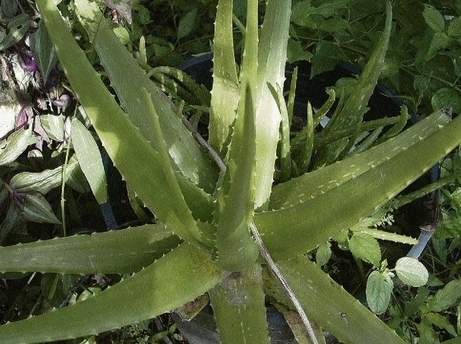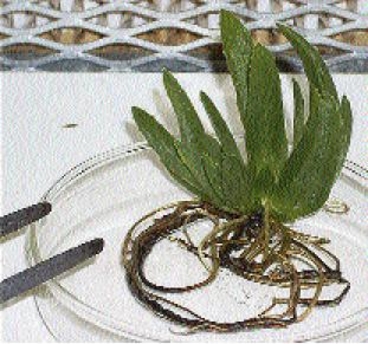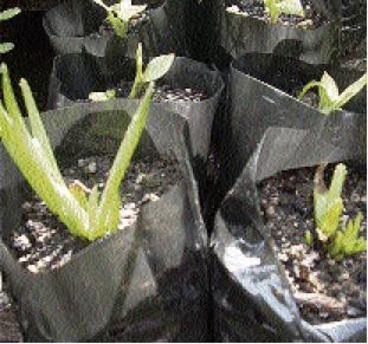Sylvia Mitchell and Rani Jagnarine, Contributors

Hardened aloe vera ready for the field.
"Four vegetables are indispensable for the well-being of man: wheat, the grape, the olive and the aloe. The first nourishes him, the second raises his spirit, the third brings him harmony and the fourth cures him."
- Christopher Columbus
ALOE VERA is a plant that is native to East and South Africa, but is cultivated in the West Indies and in Southern United States. The plant is unable to withstand cold conditions which make the Caribbean ideal planting ground for this world-recognised plant. The aloe family belongs to the xeroids, which are desert plants. Almost all xeroids have a special chemical make-up to close any wound almost immediately so the plant will not lose its precious water. The wound heals quickly, and so will ours if aloe sap is placed on it. Aloe vera leaves are thick and fleshy with a gel-like substance which contains many of aloe's medicinal properties. The aloe plant is made up of 96 per cent water. The remaining four per cent contains active ingredients such as essential oils, amino acids, minerals, vitamins, enzymes, triperpenes, glycoproteins, glycosides and polysaccharides.
External uses
Aloe is used externally to treat a number of skin irritations. Its gel has antiseptic and antibiotic properties, which make it highly valuable in treating cuts and abrasions. It is commonly used to treat burns, eczema, fungal infections and other skin conditions, as well as being a skin moisturiser, skin cleanser, scar remover and hair conditioner. Slice the aloe leaf and rub the inner mucilage on cuts; for swellings place a leaf piece in warm water then apply, and, for burns, drain the fluid directly onto the site.
Internal uses
Internally, aloe is used as a purgative, for gas, for colonic cleansing, to soothe peptic ulcers, to treat irritable bowel syndrome, hypertension, colds and nerve conditions. It has strong immunomodulatory and antitumour properties, eases inflammation and enhances the antioxidant effect of vitamins. In recent studies, it has been shown that aloe ma DNA in a manner that is helpful for people with cancer. This list is not exhaustive, as only a precursory glance on the Internet will show you. For gastrointestinal disorders, place the peeled leaf in water for four to five hours and then drink, or boil and drink to treat diabetes and to lower cholesterol levels; as an anti-inflammatory agent or blood cleanser blend and drink one cup each day for a week. Do not drink aloe for more than one to two weeks at a time, as it depletes the body of potassium.
Aloe's main user today is the cosmetic industry, due to its healing, soothing, antibacterial, and moisturising qualities. Studies have proven the use of aloe gel to enhance or accelerate cell growth in the skin. It's also found in sunscreen, after-sun lotions, creams, lotions and facial washes. Aloe can also be found in food products such as jams, jellies, yoghurt and ice cream.
Precious components
Two components of the aloe can be used - the clear inner gel and the bitter yellow gel just under the skin. The aloe gel, when exposed to oxygen for four hours oxidises and becomes worthless. So the whole process from harvesting to manufacturing has to be completed in less than four hours to stabilise the gel.
There are four basic methods of processing aloe leaves: traditional hand fillet method, whole leaf aloe, aloe powder and total process aloe.
Jamaica has the ideal climate to commercially cultivate aloe vera. The market is rapidly expanding as scientific research is being turned into many useful and effective products. Through the use of plant tissue culture, Jamaica might be able to successfully tap into this lucrative market boosting our economy with an influx of foreign currency. To harness the potential of aloe, we are developing micropropagation protocols and testing the plantlets produced to determine their yield and bioactives. After that, we aim to go into production, to fully utilise aloe's potential, for health and for wealth.
Sylvia Mitchelland Rani Jagnarine
Medicinal Plant Research Group
Biotechnology Centre
University of the West Indies


Aloe in tissue culture.
The Gleaner reserves the right not to publish comments that may be deemed libelous, derogatory or indecent. Please keep comments short and precise. A maximum of 8 sentences should be the target. Longer responses/comments should be sent to "Letters of the Editor" using the feedback form provided.
Ads by Google
More Stories
- Danville vs Dabdoub - EOJ boss, PNP candidate square off outside court
- Residents angry with Warmington
- Thugs terrorise Tangerine Place - Over the last four months, about three doctors have been robbed
- Poverty in Jamaica continues to decline
- US$500,000 loan to fix Palisadoes Road
- Cops promise no retreat
- Cabinet extends contract power
- Prime Minister of Jamaica moots research centre
- Thursday talk - Hottest topics on the cocktail circuit


